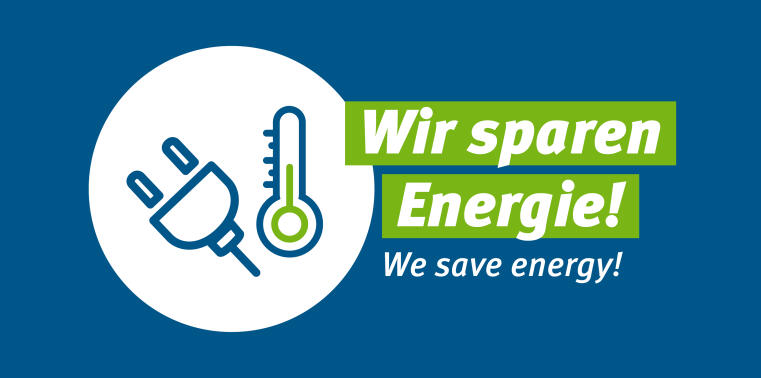

Tips on saving energy at the workplace
Heating
How does a radiator thermostat work?
The thermostat on the radiator measures the temperature of your surroundings and compares it to the temperature selected on the adjustable knob. The numbers 1-5 correlate to the desired target temperature. To heat the room to 20 °C, you would need to turn the thermostat valve to 3.
What can I do to heat more efficiently?
- Avoid overheating rooms. Try to keep the temperature at around 20 °C by adjusting the thermostat at 3. Also note that turning the thermostat up to 5 does not heat the room any faster.
- Make sure that thermostats are not covered (e.g. by furniture, drapes etc.)
- Keep doors and windows closed. When outdoor temperatures get colder, avoid keeping windows tipped for longer periods of time. So-called “shock ventilation” (ca. five minutes) has been shown to be a much more energy-efficient way to ventilate rooms. Also remember to lower the heating when you shock-ventilate.
- Will the room be empty for the next couple days? If offices and common rooms are not going to be used for longer periods of time (e.g. after work and over the weekend), turn the thermostats down to 2.
- Make sure that common areas and rooms with through traffic are not unnecessarily heated.
PCs & laptops
- Set your PC or laptop defaults to energy-saving mode when not in use. If possible, monitors should be switched off entirely during longer absences. If you work via remote access, keep in mind that you cannot switch on your work computer remotely.
- Avoid standby mode: Electronic devices constantly consume energy in standby mode. Therefore, after work or over the weekend, be sure to switch off devices entirely, i.e. do not leave them on standby. If you work via remote access, keep in mind that you cannot switch on your work computer remotely. At best, arrange to have a colleague at the office turn your PC back on after the weekend.
- To save electricity, you can reduce the brightness on your monitor.
- Only make printouts and copies if absolutely necessary.
- Add bookmarks to your browser for websites you frequently visit. Every query with your search engine uses additional energy.
- Turn off the beamer after meetings and events. This especially applies to evening events when beamers won’t be needed until the next day.
Lighting and electrical devices
- Turn on the lights only when needed and try to make the most of the daylight. When leaving the room for longer periods, switch off the lights especially in tea kitchens, hallways, copy rooms and WCs.
- When using socket or power strips, flip the toggle switch to the “off” position.
- Shut off all electrical devices which don't have to be on to avoid using the standby mode. Check which devices are actually needed. This applies to your workplace, as well as tea kitchens and lounges. Ask yourself:
- Is it necessary to keep the printer on?
- Are the monitors in standby mode when not in use?
- Do we need the refrigerator, or is it practically empty and can be shut off? Is it possible to combine the contents of the refrigerators in the corridors in one fridge?
- Even the coffee machine doesn’t have to be on all the time – it can be switched off between cups of coffee.
In the lab
Every work area has different requirements and conditions. Therefore, please check at your workplace or in your working group whether there is further potential for saving energy during your work day. The following tips are only examples and may not be applicable to every workplace.
- Only turn on instruments and lab devices when they are actually needed and avoid using standby mode.
- Close the front dampers on ventilation units.
- Check whether plant chambers can be shared by multiple groups and shut off chambers which are not in use.
- If room conditions are individually adjustable, set the times and target values to correspond to the planned experiments.
Other ideas?
Have you implemented energy-saving measures in your department which other working areas should know about? Then share your ideas and best-practice examples with us at stabsstelle.nachhaltigkeit@uni-muenster.de.
